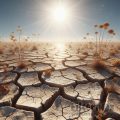Filternox warns against an approaching danger!
Global warming causes a series of significant impacts on water resources.
These effects briefly include:
 The disappearance of glaciers in the mountains, consequently leading to a decrease in the flow of rivers and a reduction in freshwater sources, deteriorating water quality.
The disappearance of glaciers in the mountains, consequently leading to a decrease in the flow of rivers and a reduction in freshwater sources, deteriorating water quality. The complete melting of all glaciers would significantly raise sea levels. The rising water levels would lead to the salination of underground resources and necessitate much more extensive use of RO systems.
The complete melting of all glaciers would significantly raise sea levels. The rising water levels would lead to the salination of underground resources and necessitate much more extensive use of RO systems. Global warming affects the hydrological cycle (precipitation, evaporation, and condensation), which could increase the risk of drought in some areas, while in other areas, it could lead to increased risks of excessive rainfall and flooding. These changes lower the underground water level and degrade water quality.
Global warming affects the hydrological cycle (precipitation, evaporation, and condensation), which could increase the risk of drought in some areas, while in other areas, it could lead to increased risks of excessive rainfall and flooding. These changes lower the underground water level and degrade water quality. Increased temperatures and changing rainfall patterns lead to the pollution of water resources and a decline in water quality. For example, excessive temperatures encourage the growth of harmful algae in water sources, which reduces the level of dissolved O2, putting pressure on the life of other organisms.
Increased temperatures and changing rainfall patterns lead to the pollution of water resources and a decline in water quality. For example, excessive temperatures encourage the growth of harmful algae in water sources, which reduces the level of dissolved O2, putting pressure on the life of other organisms. Rising temperatures and changes in precipitation regimes increase the need for irrigation in agricultural areas. This puts extra pressure on already limited water resources. Therefore, modern systems should be used in agricultural irrigation to minimize water usage. All of the possibilities mentioned above will greatly increase global inflation and impose a heavy burden on low-income groups, as well as significant additional costs for all countries.
Rising temperatures and changes in precipitation regimes increase the need for irrigation in agricultural areas. This puts extra pressure on already limited water resources. Therefore, modern systems should be used in agricultural irrigation to minimize water usage. All of the possibilities mentioned above will greatly increase global inflation and impose a heavy burden on low-income groups, as well as significant additional costs for all countries.
We should all save water and reuse it, regardless of the amount.
At Filternox, we spend a percentage of each sale on research and development.


